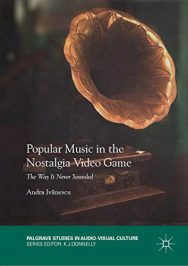Without doubt, video games have become part of popular culture; with some aspects of the game culture also introduced (and marketed) in the non-virtual present in the form of merchandise, costumes, action figures and so forth.
It is a huge market obtained the status – worth billions of dollars. And there are several movies that do not have their origin in a novel or a film script, but commercially successful computer games.
 Besides that merchandise “hardware,” there is also the music, diegetic and extra-diegetic, that works as a soundtrack to some of the more popular games and simultaneously introduces a unique past and has audiences buy those songs, while several game developers offer respective OSTs as DLC (downloadable content) online.
Besides that merchandise “hardware,” there is also the music, diegetic and extra-diegetic, that works as a soundtrack to some of the more popular games and simultaneously introduces a unique past and has audiences buy those songs, while several game developers offer respective OSTs as DLC (downloadable content) online.
The past in those games is too distant to have been experienced by the mostly young generation of gamers. Interestingly enough though, music in pioneering 1980s computer games was “one of the least considered elements of early game development.”
But even for music collectors and students of popular culture this aspect of an otherwise rather distant fan culture – computer games – turns out to be fascinating, as here, like in present day music production, video production, fashion and style in general, certain aspects of old, vintage or “recycled” and sampled music play an important role.
It is another – but in some aspects very similar – retrospectively aimed approach to aged music, uprooted from its creation and original setting. So there are many interesting parallels. Within the last ten years or so, a number of academic works on music in games in general, have turned up. With miscellaneous topics such as if music, pre-existing to the game, is experienced differently in the game. Or while playing the game, depending on the songs that play, for example, either climbing a mountain, shooting opponents or solving a puzzle, is different than without sound or music. Or if gameplay is modified or actions be tamed down or receive extra meaning through the song lyrics.
These game soundtracks, at least those studied here in Andra Invanesscu’s title, often have a very “retro” style and point to a past many decades ago. She researched the virtual video and the audio environment of commercially very successful video games such as the Fallout series, Mafia III, L.A. Noir and many others. But mostly the BioShock series (consisting of three individual games), which is a first-person-shooter set in the huge and defunct fictional formerly exclusive underwater city of Rapture that is built in art deco fashion with all details. This includes architectural features as well as audio characteristics, in this case music in the style (and partially original music) of the 1920s and 1930s that is used and played both in diegetic and extra-diegetic scenes.
The game world there also depicts social and economic details, apart from audio by Louis Armstrong, The Andrew Sisters or Annette Hanshaw, to name but a few. This sphere as Ivanescu identifies it, is remarkable, while the idea to fill a game world with nostalgia is not new. “The type of complex semiotic world built from elements of the popular culture of the past, including architecture, literature and music and film, is not unique to BioShock, but is integral to a number of video games of the twenty-first century. … These games offer their players increasingly extensive experiences of bygone eras through the lens of popular culture…” Nostalgia, a feature also present in countless movies and TV production, has for decades invaded large parts of our everyday life in politics, design and culture.
(old) other words, while culture adapted, music appropriated in its original usage of nostalgic new and has been applied in countless in video games has special place.
the (or once-popular simply as music but as an
media. reproduced or modified popular music is mostly reproduced in
interesting discourse present. title also “reproduction” work this genre.
Review by Dr. A. Ebert © 2019
Andra Ivănescu. Popular Music in the Nostalgia Video Game: The Way It Never Sounded (Palgrave Studies in Audio-Visual Culture). Palgrave Macmillan, 2019, 165 p.
